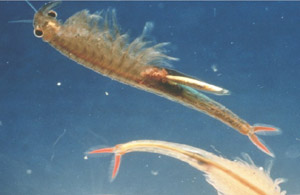Branchinecta lynchi, Vernal Pool Fairy Shrimp |
|---|
 Branchinecta lynchi, the Vernal Pool Fairy Shrimp, is a federally listed crustacean endemic to California and Oregon vernal pools. B. lynchi belongs to a group of primitive crustaceans in the class Branchiopoda and order Anostraca. B. lynchi is distinguished from other fairy shrimp by the female’s tapered, pear-shaped brooding pouch, its relatively large size (0.75-1 inch), and antenna size and shape. B. lynchi inhabits small vernal pools with cool water (10ºC) of moderate alkalinity and conductivity that are less than 1m deep. Vernal Pool Fairy Shrimp have evolved to survive the ephemeral nature of their habitats. Vernal pools are temporary wetlands that form in depressions of unplowed grasslands over a hardpan clay layer. Pools fill with winter rains and evaporate over time, lasting anywhere from a few weeks to a few months. As a result, B. lynchi completes its life cycle in a matter of weeks. Fairy shrimp eggs, called cysts, are encapsulated in a hard shell. Cysts can withstand desiccation and extreme temperatures when pools disappear; they also survive when ingested by animals. Short and long-distance dispersal occurs when cysts “hitch rides” on migrating birds or when consumed by traveling animals. Cysts will only hatch when the right conditions appear again. The current distribution of B. lynchi is limited to Oregon and California. Populations are found in Southern Oregon’s Agate Desert and in California’s Central Valley and coastal mountains. Just three occurrences of B. lynchi are also found in Southern California. Relative to other fairy shrimp, B. lynchi has a relatively large distribution, however, it is uncommon within its range. Historic B. lynchi data are nonexistent for it was described in 1990. We might assume that its distribution or abundance was much greater in the past, since vernal pools are currently an endangered habitat. California’s Central Valley has lost 75% of its vernal pool habitat and Oregon’s Agate Desert has lost 90%. The biggest threat to B. lynchi is loss of habitat. Vernal pools form in relatively flat grasslands that can be found close to metropolitan areas. This makes them prime targets for urban sprawl and agriculture. As mentioned above, both Oregon and California have already lost a huge portion of their vernal pool wetlands to these threats. Contamination of vernal pools by storm water run-off containing pesticides and other chemical residues is also negatively impacting shrimp populations. Exotic grass species that reduce the longevity of pools may also pose a threat to B. lynchi. Conservation efforts are in their beginning stages and focus on habitat conservation. B. lynchi, among a suite of other vernal pool specialists (invertebrates and plants), were federally listed in 1994. As a wetland species B. lynchi is also protected under the Clean Water Act. The Fish and Wildlife Service recently completed designation of critical habitat for the listed vernal pool species in 2003. However, counties where vernal pools might be most threatened were exempt due to economic considerations. One example is the county of Merced where the new University of California is being built. Coalitions among non-profit groups like the Nature Conservancy and government agencies have focused on land acquisitions. Active management, such as prescribed burning and cattle grazing is used in vernal pool grasslands to keep exotic plants at bay. The future success of the Vernal Pool Fairy Shrimp will depend on adequate protection of vernal pool habitats, which may prove to be difficult in a state that is experiencing such rapid growth and development. |
Resources:
|
Written by: Unknown: 2004 Updated: Eric Denemark 2008 |
Image credit: U.S. Fish and Wildlife Service |